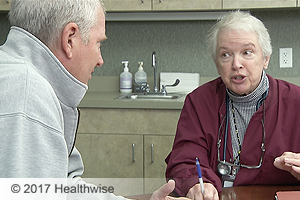Cardiac Rehabilitation: Outpatient Program
Topic Overview

Cardiac rehabilitation (rehab) typically includes an outpatient program. This program is one part, or phase, of your cardiac rehab.
The goal is to lower your risk of future heart problems.
You will take part in a supervised exercise program.
You will receive information and tools to make lifestyle changes, such as:
- Not smoking.
- Healthy eating.
- Managing stress.
- Taking your medicines.
You may also receive vocational rehab so you can return to work safely and sooner.
Your rate of recovery depends on age, gender, and other health conditions. Depending on your condition and how you respond to rehab, you may stay in a particular phase or move back and forth among the various phases. There is no set length of time that you must stay in a specific phase.
If a person has been in the hospital, the outpatient program may follow a home program. The home program can help the transition from the hospital to home. But some people might enter an outpatient program right after they leave the hospital.
Supervised exercise program
Discuss any additional physical limitations or medical issues with your doctor before you start any exercise program.
The frequency and duration of rehab sessions for each week will vary depending upon the structure of your personal program. Your exercises may vary depending on your medical history, clinical status, and symptoms, and whether you had heart surgery.
You will exercise regularly, usually in a hospital rehab facility. This exercise includes stretching, aerobic exercise, and an introduction to strength training.
Your exercise goals are to:
- Have more aerobic capacity.
- Get stronger.
- Learn how to monitor your own heart rate and rate your activity level.
- Learn stretching and strength exercises.
Your progress will be monitored by several rehab staff members. While you exercise, a health professional tracks your heart rate and rhythm, blood pressure, and symptoms.
- You will most likely exercise (walking, stationary bike riding, arm exercises) 3 to 5 times a week for 15 to 60 minutes each time, based on your condition. Your heart rate will be checked to be sure it doesn't get too high. As you progress, you will learn to check your own heart rate and rhythm.
- You may have a follow-up exercise stress electrocardiogram (ECG, EKG) during this phase to see how your heart is tolerating exercise.
Stretching and flexibility
Make stretching part of your warm-up and cooldown every time you exercise. The benefits from an increase in flexibility are numerous. And as part of your lifetime physical maintenance program, stretching will help increase the length of time that you can continue to be active. Enjoy the feeling of relaxation as you stretch. As you do each exercise in a slow and controlled manner, focus on your breathing and become more aware of your body's range of motion and positioning.
An example program:
- Frequency: at least 3 days a week
- Intensity: stretching to a position of mild discomfort
- Duration: 10 to 30 seconds for each stretch
- Repetition: 3 to 5 for each stretch
- Type: control and hold without resistance, emphasis on lower back and legs
Aerobic exercise
Phase III rehab includes a carefully monitored aerobic program that involves one or more types of exercise. Choose an exercise that you enjoy, and record how hard you exercise. Use your target heart rate (THR) and rating of perceived exertion (RPE).
You will exercise within a specific heart rate range. Over time, your staff will probably ask you to work harder when you exercise.
Sometimes exercise may cause angina (such as chest pain or discomfort). It is important to know when you reach an exercise intensity that causes angina and to exercise below that threshold. So note your heart rate intensity at any signs of chest discomfort or pain, and tell your doctor and the staff who is supervising your exercise. It is suggested that you use heart rate monitors to accurately record your heart rate and exercise 10 to 15 beats per minute (bpm) below the known threshold.
|
Mode |
Aerobic (walking, swimming, biking) |
|
Intensity |
|
|
Duration |
15 to 60 minutes |
|
Frequency |
Minimum of 3 to 5 times a week |
|
Progression |
|
Strength training
Strength training has been shown to be very effective with cardiac patients for improving muscular strength and endurance as well as help in improving coronary risk factors. It also decreases the cardiac demands of daily activities such as lifting and increases your endurance capacity for other activities. Do not start a strength-training program without discussing it with your doctor.
When you are strength training, be sure to follow recommendations for correct technique, breathing, and appropriate intensity.
|
Mode |
Strength training (hand weights, machines) |
|
Intensity |
|
|
Duration |
|
|
Frequency |
|
|
Progression |
|
Related Information
References
Other Works Consulted
- American College of Sports Medicine (2010). Exercise prescription for patients with cardiac disease. In WR Thompson et al., eds., ACSM's Guidelines for Exercise Testing and Prescription, 8th ed., pp. 207-224. Philadelphia: Lippincott Williams and Wilkins.
- Graham IM, et al. (2011). Rehabilitation of the patient with coronary heart disease. In V Fuster et al., eds., Hurst's the Heart, 13th ed., vol. 2, pp. 1513-1530. New York: McGraw-Hill.
Credits
ByHealthwise Staff
Primary Medical Reviewer Rakesh K. Pai, MD - Cardiology, Electrophysiology
E. Gregory Thompson, MD - Internal Medicine
Martin J. Gabica, MD - Family Medicine
Adam Husney, MD - Family Medicine
Specialist Medical Reviewer Richard D. Zorowitz, MD - Physical Medicine and Rehabilitation
Current as ofDecember 6, 2017
- Top of Page
Next Section:
Related Information
Previous Section:
Topic Overview- Top of Page
Next Section:
References
Previous Section:
Related Information- Top of Page
Next Section:
Credits
Previous Section:
References- Top of Page
Current as of: December 6, 2017